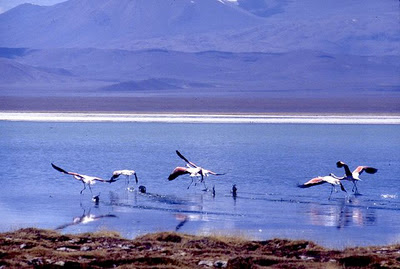Chile has no tropical rain forests – in fact, its own sizeable
sector of the tropics, between the Peruvian border and the Tropic of Capricorn,
running just north of the port city of Antofagasta, is among the world’s
driest regions, if not the driest (see the semi-ghost town of Pisagua, pictured above). But the country’s “crazy geography” (a term
popularized by geographer Benjamín
Subercaseaux), stretching to the tip of Cape Horn, provides enough diverse
habitat to support nearly 500 species of breeding or visiting birds
(Subercaseaux’s Spanish title Una Loca Geografía has been less literally
translated into English as “A Geographical Extravaganza”).
According to Álvaro Jaramillo, author of Princeton’s newly
published Birds of Chile,
this makes the country an ornithological extravaganza. There have been several
field guides to Chilean birds, but most of those cover restricted areas, such as
Enrique Couve’s and Claudio Vidal Ojeda’s bilingual Birds of the Beagle
Channel/Aves del Canal Beagle, or are difficult to find, such as the
English version of Braulio Araya’s similarly titled The Birds
of Chile. Jaramillo’s is by far the most current, with illustrations and
distribution maps for every species.
Birds of Chile accurately describes all the country’s avian
habitats, starting with the northern deserts and altiplano (high Andean steppe).
It continues south through the Mediterranean matorral and sclerophyllous
(glossy-leaf) forest, resembling the chaparral of California, through the
temperate rainforest of Patagonia’s islands and fjordlands. It ends at the Magellanic
tundra or moorland at the South American continent’s tip, home to the rare
striated caracara (pictured above). Jaramillo also covers Chile’s coastline and islands,
including Easter
Island and the Juan Fernández archipelago, as well as offshore waters and
even the Antarctic Peninsula, the Falkland
Islands and South Georgia.
For birders, one of Chile’s underappreciated gems is Parque Nacional Lauca (pictured above),
where flamingos fly above cobalt blue lakes and verdant wetlands that are home
to nearly a third of all species found in the country. At the city of Arica, on the Pacific coast, the
Atacama desert is at its driest, but its highlands near the Bolivian border get
ample summer rainfall that make species such as the giant coot, Andean goose
and Andean gull abundant. For birders from the northern hemisphere, of course,
just about everything is a new addition to their life list.
Jaramillo, whom I know slightly, is Chilean-born and still
has family there, but lives near Half Moon Bay, south of San Francisco. He
operates his own birding tours of Northern California, Argentina,
Chile
and Easter Island through Alvaro’s
Adventures, and also leads occasional trips through Uruguay.






1 comment:
What a beautiful pictures!
If you want to see more photos of birds, I share you my blog.
https://avesdecordobayargentina.blogspot.com
Post a Comment